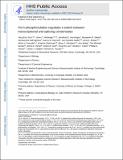Pol II phosphorylation regulates a switch between transcriptional and splicing condensates
Author(s)
Manteiga, John Colonnese; Spille, Jan Hendrik; Afeyan, Lena K.; Zamudio Montes de Oca, Alicia; Shrinivas, Krishna; Cisse, Ibrahim I; Sharp, Phillip A.; Young, Richard A.; ... Show more Show less
DownloadAccepted version (4.670Mb)
Publisher Policy
Publisher Policy
Article is made available in accordance with the publisher's policy and may be subject to US copyright law. Please refer to the publisher's site for terms of use.
Terms of use
Metadata
Show full item recordAbstract
The synthesis of pre-mRNA by RNA polymerase II (Pol II) involves the formation of a transcription initiation complex, and a transition to an elongation complex1–4. The large subunit of Pol II contains an intrinsically disordered C-terminal domain that is phosphorylated by cyclin-dependent kinases during the transition from initiation to elongation, thus influencing the interaction of the C-terminal domain with different components of the initiation or the RNA-splicing apparatus5,6. Recent observations suggest that this model provides only a partial picture of the effects of phosphorylation of the C-terminal domain7–12. Both the transcription-initiation machinery and the splicing machinery can form phase-separated condensates that contain large numbers of component molecules: hundreds of molecules of Pol II and mediator are concentrated in condensates at super-enhancers7,8, and large numbers of splicing factors are concentrated in nuclear speckles, some of which occur at highly active transcription sites9–12. Here we investigate whether the phosphorylation of the Pol II C-terminal domain regulates the incorporation of Pol II into phase-separated condensates that are associated with transcription initiation and splicing. We find that the hypophosphorylated C-terminal domain of Pol II is incorporated into mediator condensates and that phosphorylation by regulatory cyclin-dependent kinases reduces this incorporation. We also find that the hyperphosphorylated C-terminal domain is preferentially incorporated into condensates that are formed by splicing factors. These results suggest that phosphorylation of the Pol II C-terminal domain drives an exchange from condensates that are involved in transcription initiation to those that are involved in RNA processing, and implicates phosphorylation as a mechanism that regulates condensate preference.
Date issued
2019-08Department
Massachusetts Institute of Technology. Department of Biology; Massachusetts Institute of Technology. Department of Physics; Massachusetts Institute of Technology. Department of Chemical Engineering; Massachusetts Institute of Technology. Institute for Medical Engineering & ScienceJournal
Nautre
Publisher
Springer Science and Business Media LLC
Citation
Yang Eric Guo et al. "Pol II phosphorylation regulates a switch between transcriptional and splicing condensates." Nature 572(2019): 543-548 © 2018 The Author(s)
Version: Author's final manuscript
ISSN
0028-0836
1476-4687
Keywords
Multidisciplinary